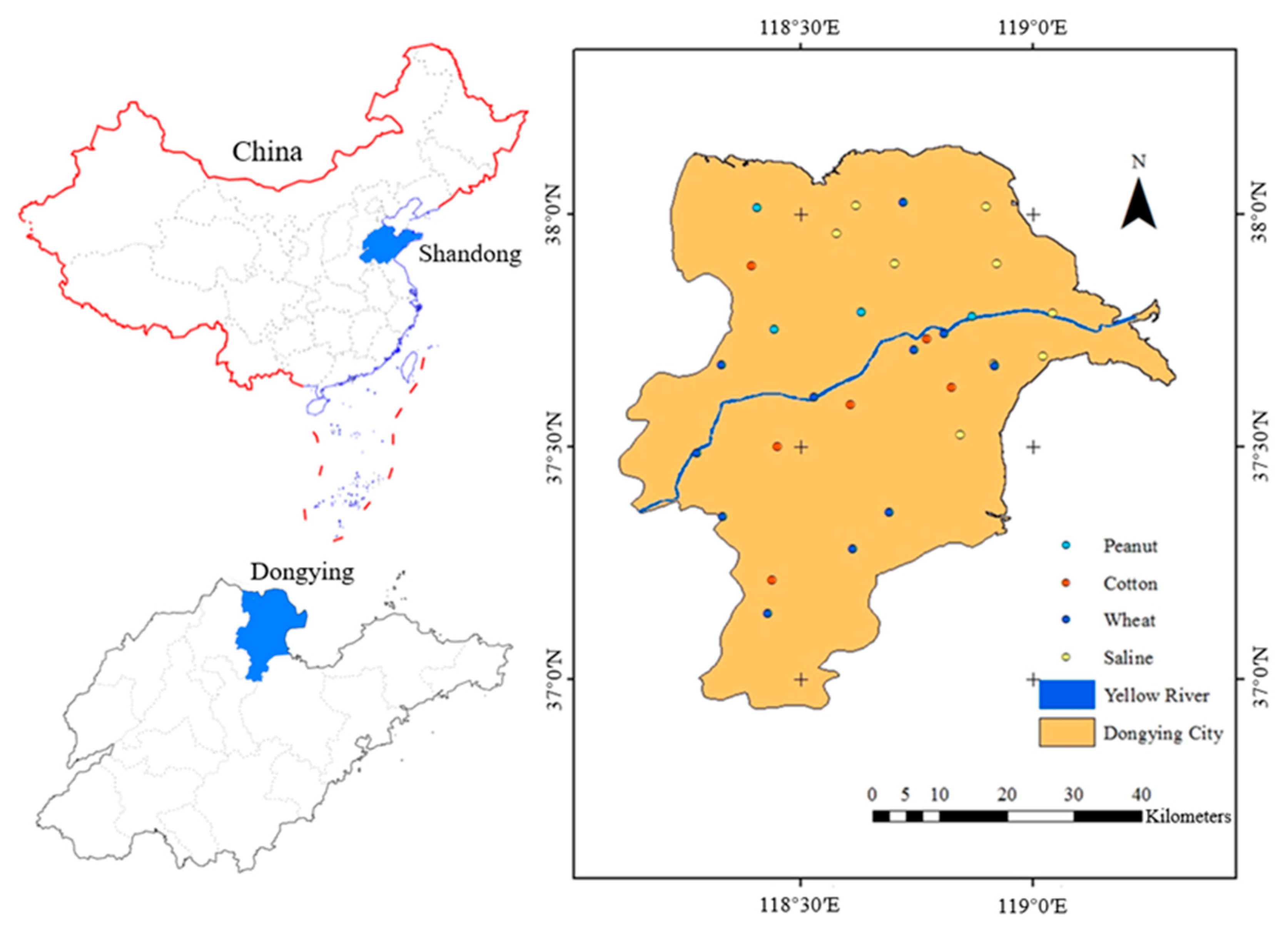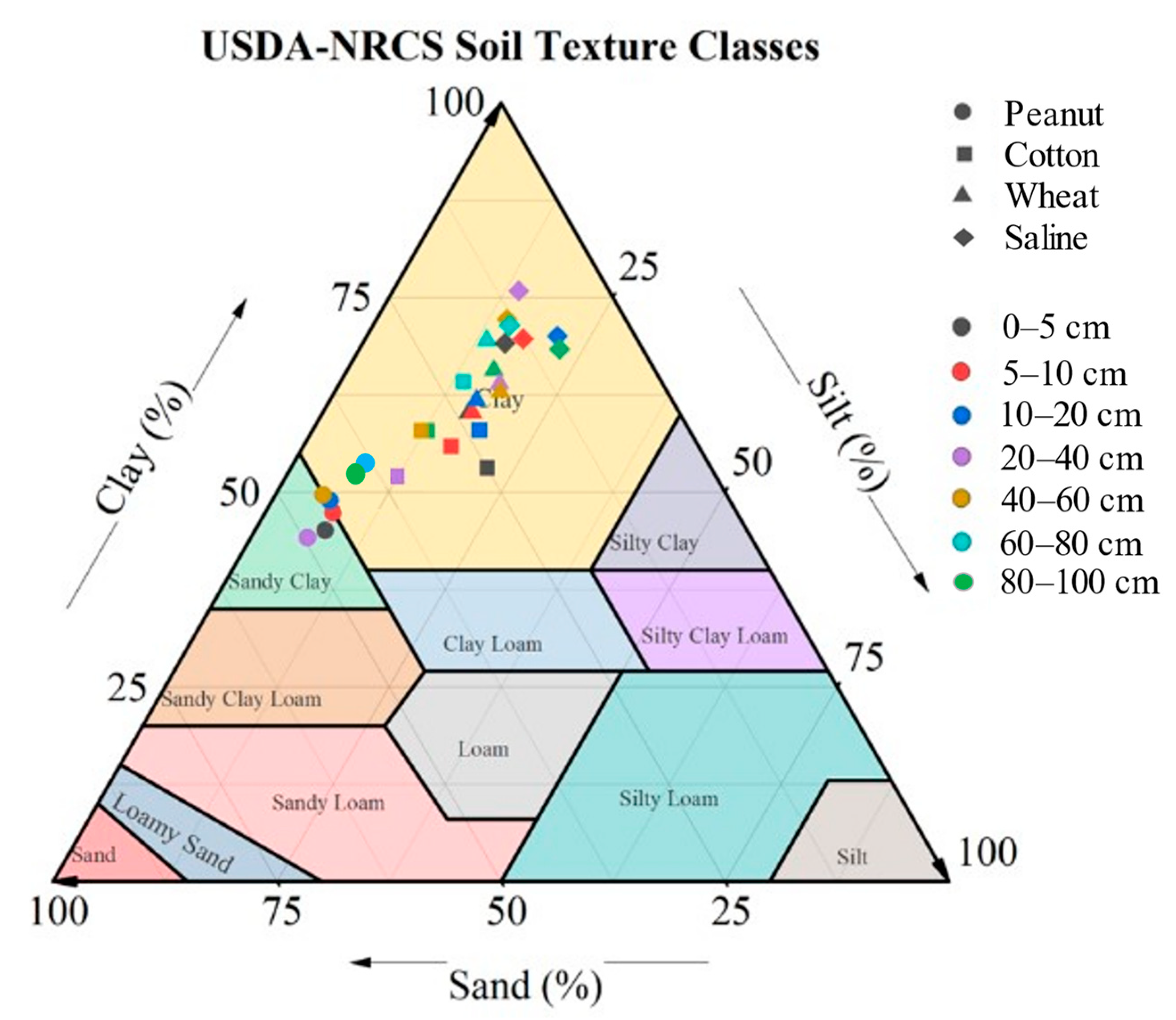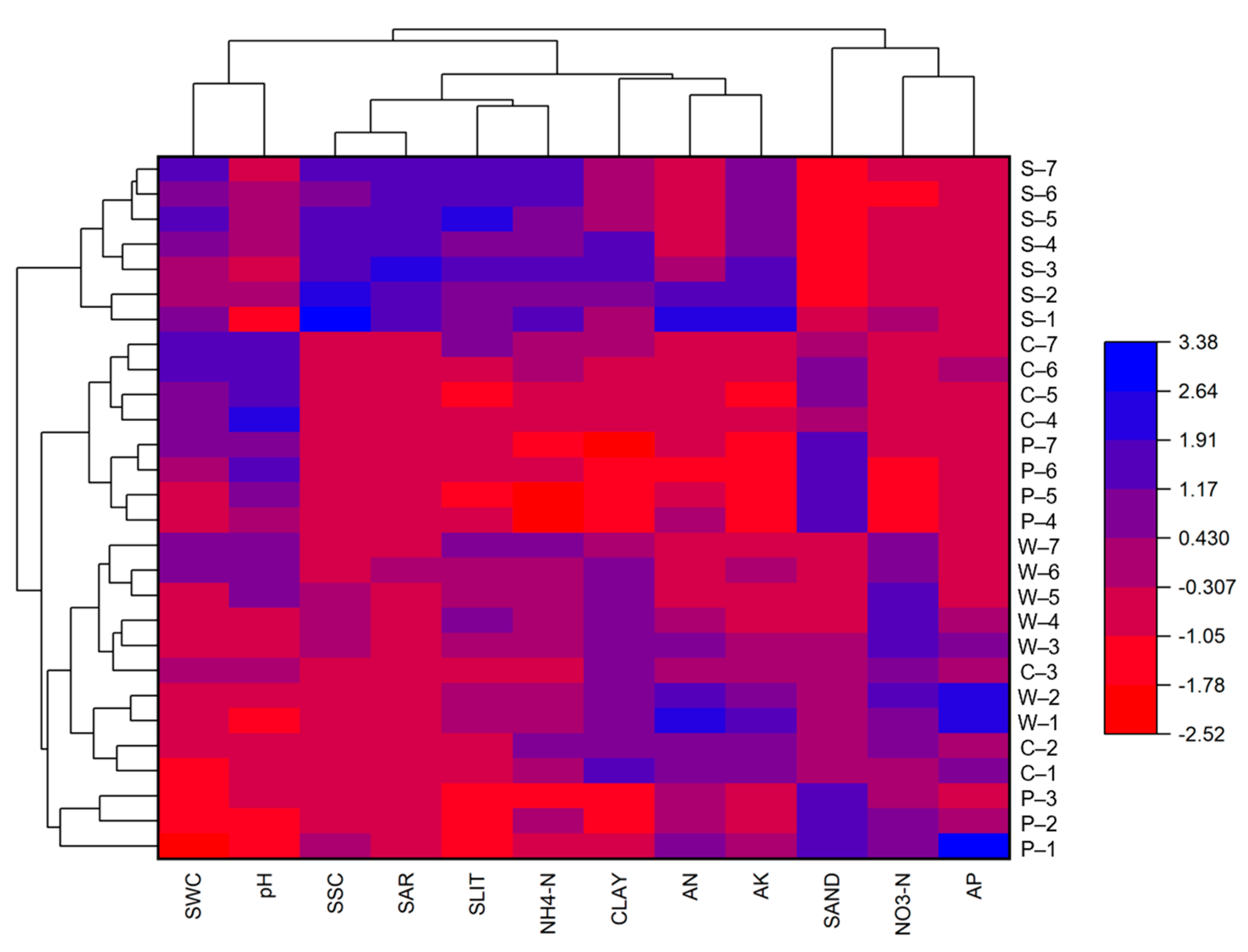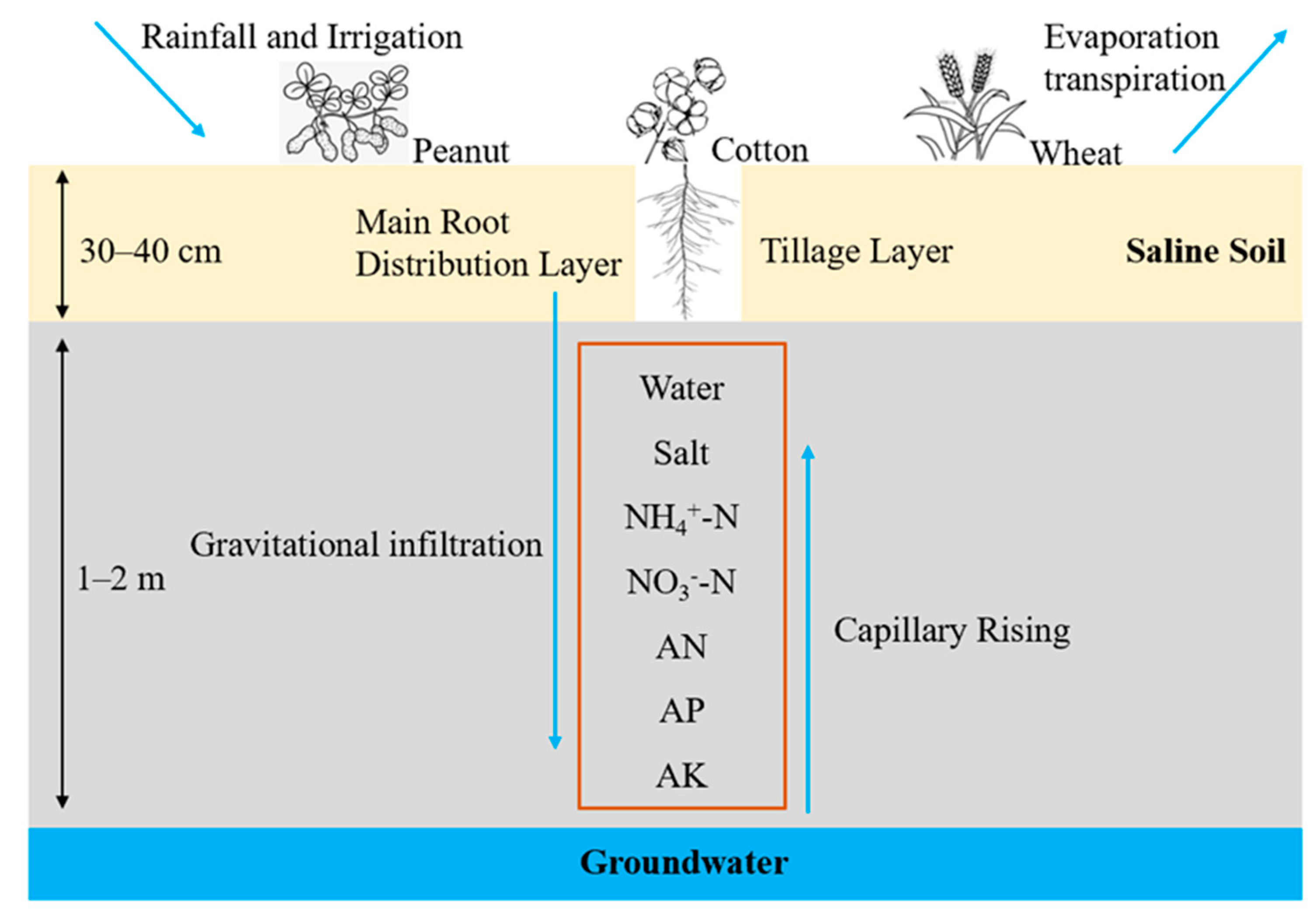Soil Salinity Weakening and Soil Quality Enhancement after Long-Term Reclamation of Different Croplands in the Yellow River Delta
Abstract
1. Introduction
2. Materials and Methods
2.1. Study Area
2.2. Soil Collection
2.3. Data Analysis
2.4. Soil Quality Assessment
- (1)
- Calculation of affiliation value
- (2)
- Calculation of index weights
- (3)
- Calculating the soil quality evaluation score
3. Results
3.1. General Soil Physical and Chemical Properties of Different Land Use Types
3.2. Vertical Distribution of Soil Physical and Chemical Properties in Different Land Use Types
3.3. Soil Quality Index for Different Land Use Types
4. Discussion
4.1. Reclamation Weakens Salinity
4.2. Reclamation Enhances Soil Nutrient
4.3. Reclamation Promotes Soil Quality
5. Conclusions
Author Contributions
Funding
Data Availability Statement
Acknowledgments
Conflicts of Interest
References
- Gao, Y.; Shao, G.; Wu, S.; Xiaojun, W.; Lu, J.; Cui, J. Changes in soil salinity under treated wastewater irrigation: A meta-analysis. Agric. Water Manag. 2021, 255, 106986. [Google Scholar] [CrossRef]
- Abdulameer, A.; Thabit, J.M.; Kanoua, W.; Wiche, O.; Merkel, B. Possible Sources of Salinity in the Upper Dibdibba Aquifer, Basrah, Iraq. Water 2021, 13, 578. [Google Scholar] [CrossRef]
- Ansari, M.; Jabbari, I.; Sargordi, F. The effect of water resources on spatial and temporal change of soil salinity in Izdkhast playa, Fars Province, Iran. Environ. Monit. Assess. 2023, 195, 63. [Google Scholar] [CrossRef]
- Hiatt, M.; Snedden, G.; Day, J.W.; Rohli, R.V.; Nyman, J.A.; Lane, R.; Sharp, L.A. Drivers and impacts of water level fluctuations in the Mississippi River delta: Implications for delta restoration. Estuar. Coast. Shelf Sci. 2019, 224, 117–137. [Google Scholar] [CrossRef]
- Wilson, C.G.; Papanicolaou, A.N.; Abban, B.K.B.; Freudenberg, V.B.; Ghaneeizad, S.M.; Giannopoulos, C.P.; Hilafu, H.T. Comparing spatial and temporal variability of the system Water Use Efficiency in a Lower Mississippi River watershed. J. Hydrol. Reg. Stud. 2022, 42, 101141. [Google Scholar] [CrossRef]
- Badawy, W.M.; Duliu, O.G.; El Samman, H.; El-Taher, A.; Frontasyeva, M.V. A review of major and trace elements in Nile River and Western Red Sea sediments: An approach of geochemistry, pollution, and associated hazards. Appl. Radiat. Isot. 2021, 170, 109595. [Google Scholar] [CrossRef]
- Gashaw, T.; Bantider, A.; Zeleke, G.; Alamirew, T.; Jemberu, W.; Worqlul, A.W.; Dile, Y.T.; Bewket, W.; Meshesha, D.T.; Adem, A.A.; et al. Evaluating InVEST model for estimating soil loss and sediment export in data scarce regions of the Abbay (Upper Blue Nile) Basin: Implications for land managers. Environ. Chall. 2021, 5, 100381. [Google Scholar] [CrossRef]
- Muoi, L.V.; Srilert, C.; Dang Tri, V.P.; Pham Van, T. Spatial and temporal variabilities of surface water and sediment pollution at the main tidal-influenced river in Ca Mau Peninsular, Vietnamese Mekong Delta. J. Hydrol. Reg. Stud. 2022, 41, 101082. [Google Scholar] [CrossRef]
- Wang, S.; Zhang, L.; She, D.; Wang, G.; Zhang, Q. Future projections of flooding characteristics in the Lancang-Mekong River Basin under climate change. J. Hydrol. 2021, 602, 126778. [Google Scholar] [CrossRef]
- Rahman, M.M.; Haque, A.; Nicholls, R.J.; Darby, S.E.; Urmi, M.T.; Dustegir, M.M.; Dunn, F.E.; Tahsin, A.; Razzaque, S.; Horsburgh, K.; et al. Sustainability of the coastal zone of the Ganges-Brahmaputra-Meghna delta under climatic and anthropogenic stresses. Sci. Total Environ. 2022, 829, 154547. [Google Scholar] [CrossRef]
- Mainuddin, M.; Kirby, J.M. Impact of flood inundation and water management on water and salt balance of the polders and islands in the Ganges delta. Ocean Coast. Manag. 2021, 210, 105740. [Google Scholar] [CrossRef]
- Zhang, F.; Jin, G.; Liu, G. Evaluation of virtual water trade in the Yellow River Delta, China. Sci. Total Environ. 2021, 784, 147285. [Google Scholar] [CrossRef] [PubMed]
- Zhu, W.; Yang, J.; Yao, R.; Wang, X.; Xie, W.; Li, P. Nitrate leaching and NH3 volatilization during soil reclamation in the Yellow River Delta, China. Environ. Pollut. 2021, 286, 117330. [Google Scholar] [CrossRef] [PubMed]
- Han, Y.; Zhao, Y.; Zhang, Y.; Wang, X.; Wu, L.; Ding, P.; Jin, L. Monitoring and Analysis of Land Subsidence in Modern Yellow River Delta Using SBAS-InSAR Technology. IOP Conf. Ser. Earth Environ. Sci. 2021, 643, 012166. [Google Scholar] [CrossRef]
- Zhang, C.; Gong, Z.; Qiu, H.; Zhang, Y.; Zhou, D. Mapping typical salt-marsh species in the Yellow River Delta wetland supported by temporal-spatial-spectral multidimensional features. Sci. Total Environ. 2021, 783, 147061. [Google Scholar] [CrossRef] [PubMed]
- Zhang, Z.; Song, Y.; Zhang, H.; Li, X.; Niu, B. Spatiotemporal dynamics of soil salinity in the Yellow River Delta under the impacts of hydrology and climate. Ying Yong Sheng Tai Xue Bao = J. Appl. Ecol. 2021, 32, 1393–1405. [Google Scholar]
- Liu, Z.; Feng, S.; Zhang, D.; Han, Y.; Cao, R. Effects of precipitation, irrigation, and exploitation on groundwater geochemical evolution in the people’s victory canal irrigation area, China. Appl. Water Sci. 2023, 13, 1. [Google Scholar] [CrossRef]
- Zhao, H.; Lin, Y.; Delang, C.O.; Ma, Y.; Zhou, J.; He, H. Contribution of soil erosion to the evolution of the plateau-plain-delta system in the Yellow River basin over the past 10,000 years. Palaeogeogr. Palaeoclimatol. Palaeoecol. 2022, 601, 111133. [Google Scholar] [CrossRef]
- Wang, Q.; Jin, H.; Yuan, Z.; Yang, C. Synergetic variations of active layer soil water and salt in a permafrost-affected meadow in the headwater area of the Yellow River, northeastern Qinghai–Tibet plateau. Int. Soil Water Conserv. Res. 2022, 10, 284–292. [Google Scholar] [CrossRef]
- Yang, H.; Sun, J.; Xia, J.; Fu, Z.; Cheng, S.; Li, T.; Shao, P.; Dong, K.; Ma, J.; Feng, L. Distribution and Assessment of Cr, Pb, Ni and Cd in Topsoil of the Modern Yellow River Delta, China. Wetlands 2021, 41, 26. [Google Scholar] [CrossRef]
- Guo, Y.; Wang, X.; Li, X.; Xu, M.; Li, Y.; Zheng, H.; Luo, Y.; Smith, P. Impacts of land use and salinization on soil inorganic and organic carbon in the middle-lower Yellow River Delta. Pedosphere 2021, 31, 839–848. [Google Scholar] [CrossRef]
- Liu, Y.; Liu, J.; Xia, X.; Bi, H.; Huang, H.; Ding, R.; Zhao, L. Land subsidence of the Yellow River Delta in China driven by river sediment compaction. Sci. Total Environ. 2021, 750, 142165. [Google Scholar] [CrossRef]
- Wu, Y.; Zhang, Y.; Dai, L.; Xie, L.; Zhao, S.; Liu, Y.; Zhang, Z. Hydrological connectivity improves soil nutrients and root architecture at the soil profile scale in a wetland ecosystem. Sci. Total Environ. 2021, 762, 143162. [Google Scholar] [CrossRef] [PubMed]
- Ahmed, W.; Wu, Y.; Kidwai, S.; Li, X.; Zhang, G.; Zhang, J. Spatial and temporal variations of nutrients and chlorophyll a in the Indus River and its deltaic creeks and coastal waters (Northwest Indian Ocean, Pakistan). J. Mar. Syst. 2021, 218, 103525. [Google Scholar] [CrossRef]
- Guo, L.; Sun, Z.; Ouyang, Z.; Han, D.; Li, F. A comparison of soil quality evaluation methods for Fluvisol along the lower Yellow River. Catena 2017, 152, 135–143. [Google Scholar] [CrossRef]
- Mahajan, G.; Das, B.; Morajkar, S.; Desai, A.; Murgaokar, D.; Kulkarni, R.; Sale, R.; Patel, K. Soil quality assessment of coastal salt-affected acid soils of India. Environ. Sci. Pollut. Res. 2020, 27, 26221–26238. [Google Scholar] [CrossRef]
- Ahmed, Z.; Ambinakudige, S. Does land use change, waterlogging, and salinity impact on sustainability of agriculture and food security? Evidence from southwestern coastal region of Bangladesh. Environ. Monit. Assess. 2023, 195, 74. [Google Scholar] [CrossRef] [PubMed]
- Liu, Q.; Li, F.; Zhang, Q.; Li, J.; Zhang, Y.; Tu, C.; Ouyang, Z. Impact of water diversion on the hydrogeochemical characterization of surface water and groundwater in the Yellow River Delta. Appl. Geochem. 2014, 48, 83–92. [Google Scholar] [CrossRef]
- Zhang, X.; Yang, Y.; Zheng, Z. Analysis of Temporal Evolution Characteristics of Annual Precipitation in the Yellow River Delta. Nat. Environ. Pollut. Technol. 2021, 20, 177–184. [Google Scholar] [CrossRef]
- Liu, Y.; Zhang, Y.; Xie, L.; Zhao, S.; Dai, L.; Zhang, Z. Effect of soil characteristics on preferential flow of Phragmites australis community in Yellow River delta. Ecol. Indic. 2021, 125, 107486. [Google Scholar] [CrossRef]
- Zhang, X.; Zhang, Z.; Wang, W.; Fang, W.-T.; Chiang, Y.-T.; Liu, X.; Ju, H. Vegetation successions of coastal wetlands in southern Laizhou Bay, Bohai Sea, northern China, influenced by the changes in relative surface elevation and soil salinity. J. Environ. Manag. 2021, 293, 112964. [Google Scholar] [CrossRef]
- Yang, H.; Xia, J.; Cui, Q.; Liu, J.; Wei, S.; Feng, L.; Dong, K. Effects of different Tamarix chinensis-grass patterns on the soil quality of coastal saline soil in the Yellow River Delta, China. Sci. Total Environ. 2021, 772, 145501. [Google Scholar] [CrossRef] [PubMed]
- Paul, G.C.; Saha, S.; Ghosh, K.G. Assessing the soil quality of Bansloi river basin, eastern India using soil-quality indices (SQIs) and Random Forest machine learning technique. Ecol. Indic. 2020, 118, 106804. [Google Scholar] [CrossRef]
- Zhang, Z.; Sun, D.; Tang, Y.; Zhu, R.; Li, X.; Gruda, N.; Dong, J.; Duan, Z. Plastic shed soil salinity in China: Current status and next steps. J. Clean. Prod. 2021, 296, 126453. [Google Scholar] [CrossRef]
- Zhai, J.; Anderson, J.T.; Yan, G.; Cong, L.; Wu, Y.; Dai, L.; Liu, J.; Zhang, Z. Decomposition and nutrient dynamics responses of plant litter to interactive effects of flooding and salinity in Yellow River Delta wetland in northeastern China. Ecol. Indic. 2021, 120, 106943. [Google Scholar] [CrossRef]
- Zhao, Y.; Xu, X.; Darilek, J.L.; Huang, B.; Sun, W.; Shi, X. Spatial variability assessment of soil nutrients in an intense agricultural area, a case study of Rugao County in Yangtze River Delta Region, China. Environ. Geol. 2009, 57, 1089–1102. [Google Scholar] [CrossRef]
- Cao, L.; Wu, D.; Liu, P.; Hu, W.; Xu, L.; Sun, Y.; Wu, Q.; Tian, K.; Huang, B.; Yoon, S.J.; et al. Occurrence, distribution and affecting factors of microplastics in agricultural soils along the lower reaches of Yangtze River, China. Sci. Total. Environ. 2021, 794, 148694. [Google Scholar] [CrossRef]
- Ma, L.; Lin, H.; Xie, X.; Dai, M.; Zhang, Y. Major role of ammonia-oxidizing bacteria in N2O production in the Pearl River estuary. Biogeosciences 2019, 16, 4765–4781. [Google Scholar] [CrossRef]
- Zhang, H.; Kariman, K.; Zhu, L.; Liu, Y.; Chen, J.; Li, D. Spatial distribution of carbon, nitrogen and sulfur in surface soil across the Pearl River Delta area, South China. Geoderma Reg. 2021, 25, e00390. [Google Scholar] [CrossRef]
- Wan, S.; Mou, X.; Liu, X. Effects of Reclamation on Soil Carbon and Nitrogen in Coastal Wetlands of Liaohe River Delta, China. Chin. Geogr. Sci. 2018, 28, 443–455. [Google Scholar] [CrossRef]
- Wang, H.; Chang, H.; Walker, T.R.; Wang, Y.; Wu, H.; Luo, Q.; Wang, X.; Zhao, Y. Characterization and risk assessment of metals in surface sediments and riparian zone soils of Liaohe River, China. Appl. Geochem. 2021, 134, 105104. [Google Scholar] [CrossRef]
- Nigatu, Z.M.; Fan, D.; You, W.; Melesse, A.M.; Pu, L.; Yang, X.; Wan, X.; Jiang, Z. Crop production response to soil moisture and groundwater depletion in the Nile Basin based on multi-source data. Sci. Total. Environ. 2022, 825, 154007. [Google Scholar] [CrossRef] [PubMed]
- Liu, L.; Wu, Y.; Yin, M.; Ma, X.; Yu, X.; Guo, X.; Du, N.; Eller, F.; Guo, W. Soil salinity, not plant genotype or geographical distance, shapes soil microbial community of a reed wetland at a fine scale in the Yellow River Delta. Sci. Total. Environ. 2023, 856, 159136. [Google Scholar] [CrossRef] [PubMed]
- Yang, X.; Li, J.; Zheng, Y.; Li, H.; Qiu, R. Salinity elevates Cd bioaccumulation of sea rice cultured under co-exposure of cadmium and salt. J. Environ. Sci. 2023, 126, 602–611. [Google Scholar] [CrossRef] [PubMed]
- Wang, L.; Qin, L.; Sun, X.; Zhao, S.; Yu, L.; Chen, S.; Wang, M. Salt stress-induced changes in soil metabolites promote cadmium transport into wheat tissues. J. Environ. Sci. 2023, 127, 577–588. [Google Scholar] [CrossRef] [PubMed]
- Guo, Z.; Qin, Y.; Lv, J.; Wang, X.; Dong, H.; Dong, X.; Zhang, T.; Du, N.; Piao, F. Luffa rootstock enhances salt tolerance and improves yield and quality of grafted cucumber plants by reducing sodium transport to the shoot. Environ. Pollut. 2023, 316, 120521. [Google Scholar] [CrossRef] [PubMed]
- Guo, X.; Du, S.; Guo, H.; Min, W. Long-term saline water drip irrigation alters soil physicochemical properties, bacterial community structure, and nitrogen transformations in cotton. Appl. Soil Ecol. 2023, 182, 104719. [Google Scholar] [CrossRef]
- Meng, L.; Qu, F.; Bi, X.; Xia, J.; Li, Y.; Wang, X.; Yu, J. Elemental stoichiometry (C, N, P) of soil in the Yellow River Delta nature reserve: Understanding N and P status of soil in the coastal estuary. Sci. Total Environ. 2021, 751, 141737. [Google Scholar] [CrossRef]
- Paul, P.L.C.; Bell, R.W.; Barrett-Lennard, E.G.; Kabir, E. Straw mulch and irrigation affect solute potential and sunflower yield in a heavy textured soil in the Ganges Delta. Agric. Water Manag. 2020, 239, 106211. [Google Scholar] [CrossRef]
- Zijun, Z.; Ge, L.; Huang, Y.; Liu, Y.; Wang, S. Coupled relationships among anammox, denitrification, and dissimilatory nitrate reduction to ammonium along salinity gradients in a Chinese estuarine wetland. J. Environ. Sci. 2021, 106, 39–46. [Google Scholar]
- Zhang, Y.; Zhang, F.; Abalos, D.; Luo, Y.; Hui, D.; Hungate, B.A.; García-Palacios, P.; Kuzyakov, Y.; Olesen, J.E.; Jørgensen, U.; et al. Stimulation of ammonia oxidizer and denitrifier abundances by nitrogen loading: Poor predictability for increased soil N2O emission. Glob. Chang. Biol. 2022, 28, 2158–2168. [Google Scholar] [CrossRef]
- Sabzzadeh, I.; Alimohammadi, S. Spatiotemporal Simulation of Nitrate, Phosphate, and Salinity in the Unsaturated Zone for an Irrigation District West of Iran Using SWAP-ANIMO Model. J. Hydrol. Eng. 2023, 28, 04022037. [Google Scholar] [CrossRef]
- Ramzan, M.; Sarwar, N.; Ali, L.; Saba, R.; Alahmadi, T.A.; Datta, R. Nitrogen enriched chemically produced carbon supplementary impacts on maize growth under saline soil conditions. J. King Saud Univ.Sci. 2023, 35, 102292. [Google Scholar] [CrossRef]
- Li, C.; Feng, H.; Luo, X.; Li, Y.; Wang, N.; Wu, W.; Zhang, T.; Dong, Q.; Siddique, K.H. Limited irrigation and fertilization in sand-layered soil increases nitrogen use efficiency and economic benefits under film mulched ridge-furrow irrigation in arid areas. Agric. Water Manag. 2022, 262, 107406. [Google Scholar] [CrossRef]
- Wu, Y.; Gu, Y.; Kang, W.; Yu, H.; Chen, S.; Quan, X.; Lu, N. Construction of microchannel charcoal cathodes with spatial-constraint capability for enhancing reduction of NO3¯ in high-salinity water. Chem. Eng. J. 2023, 452, 139126. [Google Scholar] [CrossRef]
- Wang, Q.; Zhang, H.; Li, F.; Gu, C.; Qiao, Y.; Huang, S. Assessment of calibration methods for nitrogen estimation in wet and dry soil samples with different wavelength ranges using near-infrared spectroscopy. Comput. Electron. Agric. 2021, 186, 106181. [Google Scholar] [CrossRef]
- Chen, S.; Gao, D.; Zhang, J.; Zheng, Y.; Li, X.; Dong, H.; Yin, G.; Han, P.; Liang, X.; Liu, M.; et al. Gross nitrogen transformations in intertidal sediments of the Yangtze Estuary: Distribution patterns and environmental controls. Geoderma 2023, 429, 116233. [Google Scholar] [CrossRef]
- Yang, D.; Song, L.; Jin, G. The soil C:N:P stoichiometry is more sensitive than the leaf C:N:P stoichiometry to nitrogen addition: A four-year nitrogen addition experiment in a Pinus koraiensis plantation. Plant Soil 2019, 442, 183–198. [Google Scholar] [CrossRef]
- Elsiddig, A.M.I.; Zhou, G.; Zhu, G.; Nimir, N.E.A.; Suliman, M.S.E.; Ibrahim, M.E.H.; Ali, A.Y.A. Nitrogen fertilizer promoting salt tolerance of two sorghum varieties under different salt compositions. Chil. J. Agric. Res. 2023, 83, 3–13. [Google Scholar] [CrossRef]
- Miao, J.; Li, X.; Wang, X. Effects of biochar on nitrogen and phosphorus retention in the coastal wetland soil of the Yellow River Delta, China. E3S Web Conf. 2021, 251, 02028. [Google Scholar] [CrossRef]
- Qu, F.; Meng, L.; Xia, J.; Huang, H.; Zhan, C.; Li, Y. Soil phosphorus fractions and distributions in estuarine wetlands with different climax vegetation covers in the Yellow River Delta. Ecol. Indic. 2021, 125, 107497. [Google Scholar] [CrossRef]
- Rady, M.M.; Mossa, A.-T.H.; Youssof, A.M.; Osman, A.S.; Ahmed, S.M.; Mohamed, I.A. Exploring the reinforcing effect of nano-potassium on the antioxidant defense system reflecting the increased yield and quality of salt-stressed squash plants. Sci. Hortic. 2023, 308, 111609. [Google Scholar] [CrossRef]
- Li, Y.; Wu, H.; Wang, J.; Cui, L.; Tian, D.; Wang, J.; Zhang, X.; Yan, L.; Yan, Z.; Zhang, K.; et al. Plant biomass and soil organic carbon are main factors influencing dry-season ecosystem carbon rates in the coastal zone of the Yellow River Delta. PLoS ONE 2019, 14, e0210768. [Google Scholar] [CrossRef] [PubMed]
- Liang, X.; Yuan, G.; Feng, L.; Bi, D.; Wei, J. Soil properties and the growth of wheat (Triticum aestivum L.) and maize (Zea mays L.) in response to reed (phragmites communis) biochar use in a salt-affected soil in the Yellow River Delta. Agric. Ecosyst. Environ. 2020, 303, 107124. [Google Scholar] [CrossRef]
- Su, X.; Lu, C.; Li, M.; Wang, Y.; Wang, N. Using 222Rn temporal and spatial distributions to estimate the groundwater discharge rate and associated nutrient fluxes into high salinity lakes in Badain Jaran Desert, Northwest China. Sci. Total. Environ. 2023, 857, 159359. [Google Scholar] [CrossRef]
- Lian, J.; Cheng, L.; Zhai, X.; Wu, R.; Huang, X.; Chen, D.; Pan, J.; Shohag, M.; Xin, X.; Ren, X.; et al. Zinc glycerolate (Glyzinc): A novel foliar fertilizer for zinc biofortification and cadmium reduction in wheat (Triticum aestivum L.). Food Chem. 2023, 402, 134290. [Google Scholar] [CrossRef]






| Soil Properties | Peanut (n = 4) | Cotton (n = 6) | Wheat (n = 11) | Saline (n = 9) |
|---|---|---|---|---|
| SWC (%) | 19.28 ± 4.94 c | 24.32 ± 4.43 ab | 22.14 ± 3.50 bc | 26.88 ± 2.26 a |
| pH | 8.46 ± 0.13 a | 8.55 ± 0.13 a | 8.46 ± 0.09 a | 8.44 ± 0.04 a |
| SSC (g/kg) | 1.44 ± 0.34 b | 1.69 ± 0.27 b | 1.91 ± 0.12 b | 4.52 ± 0.91 a |
| SAR | 9.12 ± 1.49 c | 14.63 ± 3.80 b | 18.57 ± 2.97 b | 75.34 ± 5.74 a |
| Sand (%) | 39.96 ± 1.53 a | 27.62 ± 4.61 b | 20.01 ± 2.73 c | 11.76 ± 2.39 d |
| Silt (%) | 51.92 ± 2.76 d | 57.13 ± 3.97 c | 63.45 ± 3.31 b | 70.97 ± 2.53 a |
| Clay (%) | 8.12 ± 1.55 b | 15.25 ± 3.71 a | 16.54 ± 1.52 a | 17.27 ± 3.31 a |
| NH4+-N (mg/kg) | 1.53 ± 0.32 c | 1.85 ± 0.19 b | 2.05 ± 0.15 b | 2.36 ± 0.12 a |
| NO3−-N (mg/kg) | 308.92 ± 244.00 b | 328.47 ± 173.04 b | 697.19 ± 108.30 a | 162.39 ± 77.10 b |
| AN (mg/kg) | 30.87 ± 13.83 a | 34.53 ± 15.90 a | 41.89 ± 23.68 a | 39.73 ± 21.90 a |
| AP (mg/kg) | 14.35 ± 12.79 a | 12.49 ± 3.64 a | 17.70 ± 10.88 a | 8.92 ± 0.95 a |
| AK (mg/kg) | 99.82 ± 42.58 c | 134.25 ± 49.09 bc | 158.63 ± 40.26 b | 220.34 ± 30.58 a |
| River Delta | Yellow | Yangtze | Pearl | Liao |
|---|---|---|---|---|
| NH4+-N (mg/kg) | 4.2–42.33 | 5.94–29.30 | 47.59–739.61 | 3.26–13.79 |
| NO3−-N (mg/kg) | 1.49–22.34 | 1.46–88.61 | 1.1–1313 | 12.07–30.34 |
| AN (mg/kg) | 15–64 | 99.74–175.9 | 13.7–221.3 | 15–105.24 |
| AP (mg/kg) | 1.07–25.3 | 5.23–169.86 | 3.8–227.2 | 9.58–21.61 |
| AK (mg/kg) | 37–920 | 40.81–235.10 | 30–540 | 60–177 |
| References | [12,28] | [36,37] | [38,39] | [40,41] |
| Criteria | AN (mg/kg) | AP (mg/kg) | AK (mg/kg) |
|---|---|---|---|
| Level I | >150 | >40 | >200 |
| Level II | 120–150 | 20–40 | 150–200 |
| Level III | 90–120 | 10–20 | 100–150 |
| Level IV | 60–90 | 5–10 | 50–100 |
| Level V | 30–60 | 3–5 | 30–50 |
| Level VI | <30 | <3 | <30 |
| Principal Component Number | PC1 | PC2 | PC3 |
|---|---|---|---|
| SWC | 0.18494 | −0.43057 | 0.12004 |
| pH | −0.12364 | −0.42396 | 0.28878 |
| SSC | 0.37565 | −0.02078 | −0.35406 |
| SAR | 0.37965 | −0.11142 | −0.30557 |
| SAND | −0.3909 | 0.05741 | −0.28888 |
| SLIT | 0.37131 | −0.14757 | 0.15535 |
| CLAY | 0.30304 | 0.11759 | 0.4314 |
| NH4+-N | 0.37315 | 0.03971 | 0.14256 |
| NO3−-N | −0.04183 | 0.37519 | 0.56797 |
| AN | 0.12763 | 0.43845 | −0.1726 |
| AP | −0.05656 | 0.43008 | 0.02495 |
| AK | 0.34968 | 0.25211 | −0.1282 |
| SQI | ≤0.30 | 0.30–0.40 | 0.40–0.50 | 0.50–0.60 | >0.60 |
|---|---|---|---|---|---|
| Criteria | Level I | Level II | Level III | Level IV | Level V |
| Quality | Very low | Low | Medium | High | Very high |
Disclaimer/Publisher’s Note: The statements, opinions and data contained in all publications are solely those of the individual author(s) and contributor(s) and not of MDPI and/or the editor(s). MDPI and/or the editor(s) disclaim responsibility for any injury to people or property resulting from any ideas, methods, instructions or products referred to in the content. |
© 2023 by the authors. Licensee MDPI, Basel, Switzerland. This article is an open access article distributed under the terms and conditions of the Creative Commons Attribution (CC BY) license (https://creativecommons.org/licenses/by/4.0/).
Share and Cite
Liu, S.; Zhang, Q.; Li, Z.; Tian, C.; Qiao, Y.; Du, K.; Cheng, H.; Chen, G.; Li, X.; Li, F. Soil Salinity Weakening and Soil Quality Enhancement after Long-Term Reclamation of Different Croplands in the Yellow River Delta. Sustainability 2023, 15, 1173. https://doi.org/10.3390/su15021173
Liu S, Zhang Q, Li Z, Tian C, Qiao Y, Du K, Cheng H, Chen G, Li X, Li F. Soil Salinity Weakening and Soil Quality Enhancement after Long-Term Reclamation of Different Croplands in the Yellow River Delta. Sustainability. 2023; 15(2):1173. https://doi.org/10.3390/su15021173
Chicago/Turabian StyleLiu, Shanbao, Qiuying Zhang, Zhao Li, Chao Tian, Yunfeng Qiao, Kun Du, Hefa Cheng, Gang Chen, Xiaoyan Li, and Fadong Li. 2023. "Soil Salinity Weakening and Soil Quality Enhancement after Long-Term Reclamation of Different Croplands in the Yellow River Delta" Sustainability 15, no. 2: 1173. https://doi.org/10.3390/su15021173
APA StyleLiu, S., Zhang, Q., Li, Z., Tian, C., Qiao, Y., Du, K., Cheng, H., Chen, G., Li, X., & Li, F. (2023). Soil Salinity Weakening and Soil Quality Enhancement after Long-Term Reclamation of Different Croplands in the Yellow River Delta. Sustainability, 15(2), 1173. https://doi.org/10.3390/su15021173










